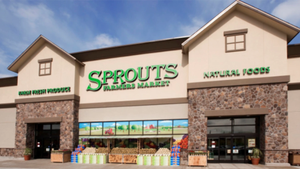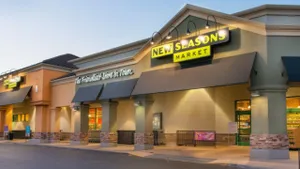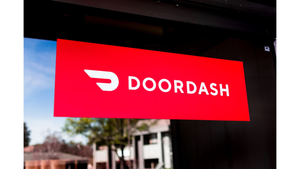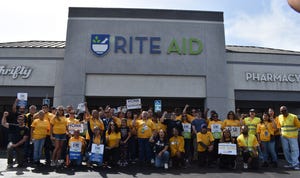SUPERCENTER DEMONSTRATES WAL-MART'S MICRO-MERCHANDISING
JANE, Mo. -- Wal-Mart Stores used a new 160,000-square-foot supercenter here to show off new design features and demonstrate its "store of the community" micro-merchandising in action. The tour was part of a media conference that the Bentonville, Ark., retailer held this month.The supercenter, which opened three months ago, straddles the Arkansas-Missouri line. It caters to retirees who buy golf balls,
April 18, 2005
Katherine Bowers
JANE, Mo. -- Wal-Mart Stores used a new 160,000-square-foot supercenter here to show off new design features and demonstrate its "store of the community" micro-merchandising in action. The tour was part of a media conference that the Bentonville, Ark., retailer held this month.
The supercenter, which opened three months ago, straddles the Arkansas-Missouri line. It caters to retirees who buy golf balls, birdseed and lettuce, and to a younger crowd, which prefers beer, frozen chicken breasts and inflatable pools, said Del Sloneker, divisional vice president. Sloneker led the tour.
The store showed Wal-Mart's flexibility, despite its corporate size, and sensitivity to the local demographic.
For instance, when store managers noticed long lines and the older crowd shunning self-checkout, they yanked the machines in favor of traditional registers.
"The customer voted 'no,' so we didn't waste any time," said Sloneker.
The store's younger shoppers drive from dry Benton County, Ark., to the Missouri line, where alcohol can be legally sold. The store has a 15,000-square-foot liquor department, with its own entrance and a 6,000-square-foot, walk-in cooler stocked with beer.
The supercenter tour was part of an unprecedented conference Wal-Mart held April 5 and 6 to refute its critics and mend fences with a media that's been critical of its employment and expansion practices.
During a series of executive presentations, Wal-Mart reiterated its belief in the supercenter format, and said it would open as many large stores as possible before back-filling with its Neighborhood Markets because of the superior return on investment from supercenters.
"We want to get the supercenters in the ground as fast as possible," said Thomas Schoewe, chief financial officer. He later added that the three supercenters the retailer operates in Southern California, where it faces rancorous opposition, are among the "most successful stores we have in operation."
Neighborhood Markets, the supermarket-drug store hybrid currently clustered in the Southeast, but expanding gradually in to new markets like Las Vegas, are being built at 39,000 square feet.
"If you write down one word about Neighborhood Markets, please make it 'convenience,"' said Pam Kohn, senior vice president, Neighborhood Markets, during her presentation. "We want to be right in the neighborhoods, surrounded by customers' homes."
Like all new format supercenters, the Jane store has separate food and general merchandise entrances, now with larger exterior signs. At the food entry, the retailer had a new-release DVD (Johnny Depp's "Finding Neverland") and a selection of pastries displayed, followed by rotisserie chicken for $3.98.
Wal-Mart will be testing its Grab-N-Go "honor bar" coffee and pastries in some new supercenters, although this store did not have it. The concept, borrowed from the Neighborhood Market, allows customers to grab a coffee and doughnut, and simply drop a payment into a box.
Although it was before 8 a.m. on a Wednesday, the Jane store had fried chicken and numerous side dishes already prepared. The store has a significant number of locals who work evening shifts and who pick up dinner in the morning, Sloneker said.
Although bananas are Wal-Mart's best-selling produce item nationwide, lettuce was No. 1 in this store, followed by bananas, strawberries and potatoes, said Sloneker, who oversees 517 stores from Ohio to Maine. When managers in Jane noticed exceptional lettuce sales, they moved the product category to a separate, refrigerated display of mainly bagged salads.
A 48-ounce bag of Great Value private-label chicken breasts, priced at $7.87, was the best-selling frozen food item. The company was selling about 49 bags per day, and had 279 pieces in stock, said Sloneker, checking the numbers on his handheld Telxon computer.
The Telxon, resembling a scan gun, holds a year's worth of that specific store's data, a sales history that helps store managers make decisions on displays. Seeing that strawberries sold well last year during week 13, for example, might prompt them to create a shortcake display in a prominent location. The Telxon data is audited annually, but glitches slip in. A Tropicana pineapple juice in a glass bottle was out of stock, but the Telxon listed four pieces in inventory.
Beef is the top-selling meat in Jane, followed by ground beef, chicken and fish. The 18-egg stockkeeping unit was a top seller in its category; demand for organic eggs had been sluggish.
The store has a designated in-stock team of 18, plus two leaders who create replenishment lists at the beginning of each shift. On some nights, the store receives three trailers worth of freight.
The liquor department contained a massive Budweiser display and a section of glassware and other bar accessories. A locked case contained Glenlivet Scotch and other top-shelf liquors. The $7.97 build-your-own six-pack, which allowed customers to chose from a selection of imports and microbrews, has been popular.
Also popular are inflatable pools. At $297 each, they were the No. 1 item in the toy department. The store also sold 17 Playstation portables, at $248.82 apiece, in two weeks.
The Jane store displayed the retailer's new sign package, a significant upgrade aesthetically and functionally from the previous.
The ceiling-hung directional signs, done with white type on a black background, include arrows pointing toward popular departments and pictorial icons in blue -- an "Rx" for pharmacy, for example.
The store emphasized Wal-Mart's move toward building materials it hopes will prove more durable and efficient. There are skylights and automatic dimming programs for interior lighting.
Floors are now terra-cotta-stained concrete. This has reduced slip-and-fall accidents, since spills are more visible on concrete than tile.
Bathrooms have been upgraded with stainless-steel stalls, ceramic tile and self-flushing toilets.
About the Author
You May Also Like




